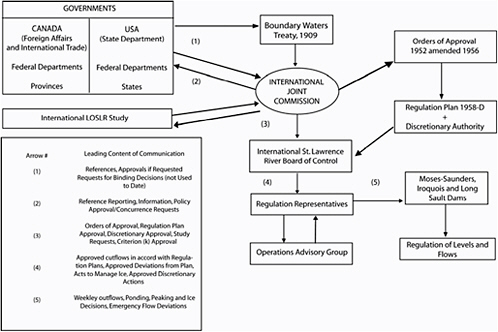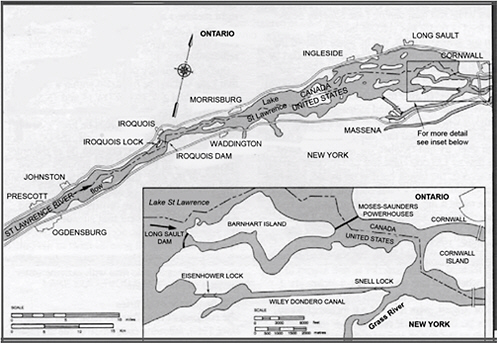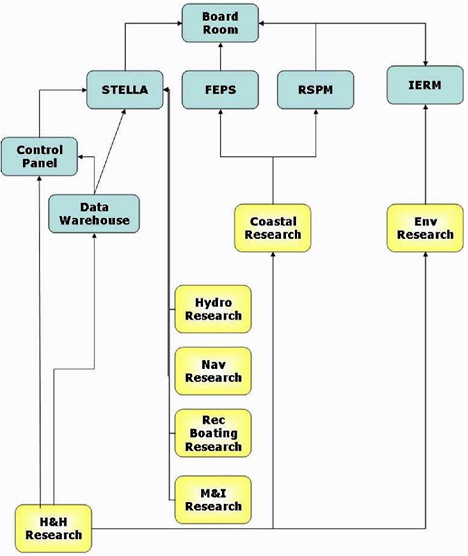Chapter 1
Introduction
In 1999, the International Joint Commission (IJC) commissioned the Lake Ontario-St. Lawrence River (LOSLR) Study as a 5-year, more than $20 million study. In identifying scientifically-based adjustments to water level and flow regulation, the LOSLR Study’s purpose is to (1) review the current regulations of levels and flows in the LOSLR system with consideration for the impact of regulation on a variety of interests; (2) build a progressive understanding of the system; and (3) provide a strong scientific foundation for deciding future regulation plan options. At the broadest level, the vision of the LOSLR Study1 is, “to contribute to economic, environmental and social sustainability of the Lake Ontario and St. Lawrence River System.” The goals of the Study are to identify flow regulation plans and criteria that serve the range of stakeholder interests, are widely accepted, and take into account hydroclimatic conditions in the basin.
The LOSLR Study was designed within the context of seven guiding principles2:
-
Criteria and Regulation Plans will contribute to the ecological integrity of the Lake Ontario-St. Lawrence River System ecosystem.
-
Criteria and Regulation Plans will produce a net benefit to the Lake Ontario-St. Lawrence River System and its users and will not result in disproportionate loss to any particular interest or geographic area.
-
Criteria and Regulation Plans will be able to respond to unusual or unexpected conditions affecting the Lake Ontario-St. Lawrence River System.
-
Mitigation alternatives may be identified to limit damages when considered to be appropriate.
-
Regulation of the Lake Ontario-St. Lawrence River System will be adaptable to the extent possible, to accommodate the potential for changes in water supply as a result of climate change and variability.
-
Decision making with respect to the development of the Lake Ontario-St. Lawrence River System Criteria and Plans will be transparent, involving and considering the full range of interests affected by any decisions with broad stakeholder and public input.
-
Criteria and Regulation Plans will incorporate current knowledge: state-of-the-art technology; and the flexibility to adapt to future advances in knowledge, science, and technology.
|
1 |
Full text of the vision is available online at http://www.losl.org/about/vision-e.html; August 2, 2005. |
|
2 |
Available online at http://www.losl.org/about/vision-e.html. |
These economic, environmental, and social criteria represent an unprecedented expansion of inquiry related to water regulation in the basin. Although not exhaustive (as discussed later in this report), the LOSLR scope extends far beyond the historical preference given to domestic water use, navigation, hydropower, and irrigation (Boundary Waters Treaty, 1909, Article VIII).
This chapter introduces the Lake Ontario St. Lawrence River Study (LOSLR Study or “the Study”) and the independent review of it by the National Research Council (NRC) in collaboration with the Royal Society of Canada (RSC). The first part of the chapter introduces the Lake Ontario-St. Lawrence River system, including its geographic setting and the water level and flow regulation issues that prompted the LOSLR Study. Next is a brief outline of the LOSLR Study, including its scope and organization. The final section of the chapter describes the NRC independent review, the statement of task from the IJC, the evaluation criteria used to address the statement of task, and the organization of chapters that follow.
LAKE ONTARIO-ST. LAWRENCE RIVER BASIN
Geographic Setting
Shared by the United States and Canada, the Lake Ontario-St. Lawrence River (LOSLR) basin drains the largest freshwater lake system in the world (Figure 1-1). It includes the lower Niagara River, Lake Ontario, and the St. Lawrence River basin. The lower Great Lakes shared international waters extend from the lower Niagara River, downstream from Niagara Falls, through Lake Ontario and the upper St. Lawrence River to just downstream from the Moses-Saunders Dam near the towns of Cornwall, Ontario and St. Regis and Massena, New York. (Figure 1-1). From there, the St. Lawrence River flows northeast through the Province of Quebec, Canada, until it finally discharges into the Gulf of St. Lawrence.
The LOSLR basin supplies drinking water for some 8.6 million people. It supports complex aquatic, wetland, and coastal ecosystems affected by water level and flow fluctuations. It serves as a navigation route for global and regional maritime shipping from the Port of Montreal through the St. Lawrence Seaway that depends upon reliable flow regulation. Hydropower production at the Moses-Saunders facilities currently averages 13 million megawatt hours per year. Recreational boaters and waterfront communities enjoy the beautiful water body and coastal environments, though shoreline properties, municipalities, and infrastructure face flooding and erosion hazards.
Lake Ontario drains 64,030 km2. It has the smallest surface area of all of the Great Lakes (18,960 km2), but the second greatest average depth (86 m). Lakewide monthly water levels over the past century range from an historic low of 73.74 m (December 1934) to a record high of 75.76 m (June 1952) (USACE, Detroit, 2005; IGLD 1985). A difference of even a half-meter in water levels can aggravate flooding, erosion, boating problems, wetland habitat and fish spawning conditions.
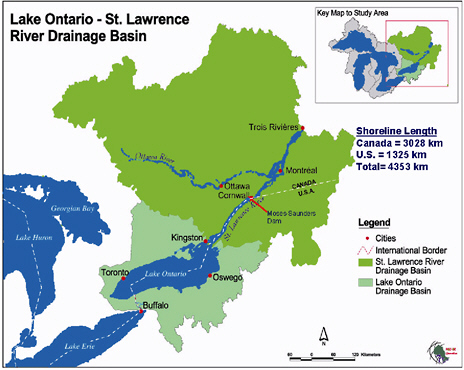
FIGURE 1-1 Map of LOSLR drainage basin. SOURCE: Map courtesy of the IJC.
Under the Boundary Waters Treaty of 1909, the Canadian and United States governments established the International Joint Commission (IJC) to address mutual water-related concerns (Boundary Waters Treaty, 1909; available on-line at http://www.ijc.org/rel/agree/water.html), such as water level and flow regulation and their effects.
Water Regulation in the Lake Ontario-St. Lawrence River Basin
Water regulation activities in the LOSLR system date to the mid-20th century. Figure 1-2 describes the water level regulation institutional organization for the Lake Ontario-St. Lawrence River. The 1952 Order of Approval, amended in 1956, authorized construction of the Moses-Saunders Dam, Iroquois Dam, and Long Sault Dam in the International Rapids Section of the St. Lawrence River (Figure 1-3). The 1952 Order of Approval also created the International St. Lawrence River Board of Control (ISLRBC or Board of Control) to operate the Moses-Saunders Dam and power plant, completed in 1958, which are the principal structures affecting water levels and flows (Figure 1-4).
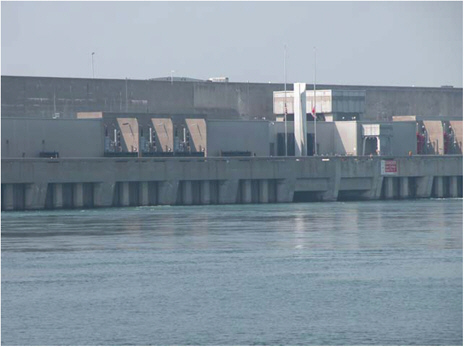
FIGURE 1-4 Moses-Saunders Dam. Photo courtesy of James Wescoat.
In the early 1950s, wide fluctuations in water levels led to a series of changes in the regulation plan, culminating in Plan 1958D, adopted in 1963 (Clinton Edmonds and Associates, 2002). Figure 1-5 shows average water levels from 1918 to 2003, which suggests that 1958D has reduced extreme high and low lake levels (IGLD, 1985), and increased mean water levels.
The St. Lawrence Board of Control is authorized to deviate from Plan 1958D in response to emergencies and within reasonable limits to reduce negative impacts and increase net benefits for stakeholders. By the late 1990s, deviations reportedly occurred over half of the year, leading to a de facto regulation plan known as Plan 1958DD (Plan 1958D with Deviations). The extent of deviations from Plan 1958D has raised the question of whether another regulation plan could provide greater benefits and fewer losses than Plan 1958D.
As the IJC considers possible attributes of a new water regulation plan, it will use the LOSLR study to provide scientific and practical bases for deliberating among candidate regulation plan options. The IJC has been clear about certain components needed to improve upon 1958D for regulating water levels in the LOSLR basin: sound scientific foundation, public participation, transparency in the development and decision making process of regulation plans, and environmental considerations will be included in the 1958D regulation plan successor.
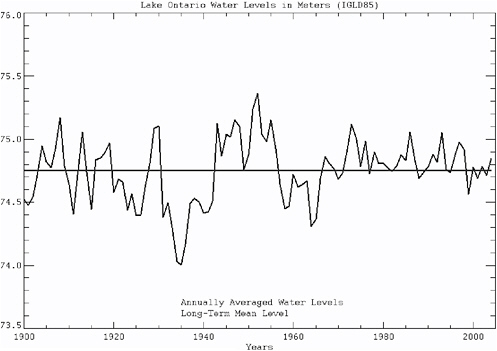
FIGURE 1-5 Lake Ontario Water Levels in Meters. SOURCE: IGLD85. Available online at http://www.glerl.noaa.gov/data/now/wlevels/lowlevels/plot/Ontario.png.
LOSLR STUDY STRUCTURE
LOSLR Study Design
The LOSLR Study was designed to address a broad range of human interests and environmental values affected by water level fluctuations. The suite of subjects in the Study reflects a broad spectrum of considerations in regional water resources planning that may serve as a case study for other regional efforts to balance several, sometimes competing, water uses. In the LOSLR Study, empirical and modeling studies were commissioned to form the scientific foundations for water regulation plans. Individual study subjects include wetlands, species at risk, recreational boating, fisheries, coastal processes of erosion and flood potential, commercial navigation, hydropower, industrial, municipal and domestic water intakes, public information and education, and hydrologic modeling. Individual studies were designed and conducted as separate investigations, and study results were integrated into the SVM. The SVM links results from the empirical studies; hydrologic, coastal, economic and environmental models; and stakeholder input (Figure 1-6). The SVM’s Board Room provides a mechanism for understanding and presenting tradeoffs among the different regulation plan options.
LOSLR Study Administration
Three groups have roles in the LOSLR Study effort. First, the LOSLR Study Board, which has overall responsibility for the Study, provides guidance and direction to the LOSLR study management and staff, and oversees Study scientific aspects. Fourteen people, half from the United States and half from Canada, form the International LOSLR Study Board (appointed in 2000 by the IJC).
Nine technical work groups (TWGs) form the second tier of organizations in the LOSLR Study. More than 150 scientists and technical experts from the United States and Canada work with the TWGs to carry out the scientific work of the Study by conducting empirical studies, developing models, and reviewing data. The nine TWGs are in the technical areas of: wetlands, recreational boating, fisheries and the environment, coastal processes including erosion and flood potential, commercial navigation, hydropower, industrial, municipal and domestic water intakes, public information and education, and hydrologic modeling. Results from the TWG studies are conveyed to the Study Board, integrated into the SVM, and used in the formulation and evaluation of regulation plan options.
A third group that is part of the LOSLR Study, but has no administrative, management, or oversight role, is the Public Interest Advisory Group (PIAG). PIAG was developed by the IJC to ensure healthy public participation, debate, input, and guidance related to the study process. The PIAG’s role is to foster public understanding on the causes of water level problems and how possible solutions to some problems affect others. PIAG represents stakeholder interests, convenes public meetings around the basin, and publishes a newsletter, Ripple Effects.3
THE INDEPENDENT REVIEW OF THE LOSLR STUDY
Near the middle of the last year of the 5-year LOSLR Study, the IJC asked the NRC and the RSC to provide an independent review of a select body of scientific and technical work from three of the nine TWGs.4 Given the timing of this review in the course of the LOSLR study timeline, a fast-track review in the last half of 2005 began shortly afterwards: a bi-national committee was formed in May, the first meeting was held in June, the second meeting a month later and, following external peer review, the report was submitted to IJC in October, 2005.
The Statement of Task
The overall charge to the NRC committee was to provide an independent review of the select scientific reports and models that the Study Board will use as the bases for evaluating and choosing among regulation plan options. The statement of task (Box 1-1) contains three charges to the committee (more information con-
|
3 |
Available online at http://www.losl.org/news/news-e.html. |
|
4 |
The NRC provided the overall organization and management for the review. |
|
BOX 1-1 NRC Committee shall perform an independent review of the Lake Ontario/St. Lawrence River reports in the following areas: wetlands science and species at risk, the Flood Erosion and Prediction System (FEPS), the Integrated Ecological Response Models (IERM), and the Shared Vision Model (SVM). The level of emphasis for these various areas shall be approximately as follows: wetlands 15%, species at risk 15%, FEPS 10%, IERM 20%, SVM 40%, and reflect the International Joint Commission’s (IJC) determination of its priorities in this effort. The overarching charge shall be to evaluate the appropriateness and sufficiency of the studies and models used to inform decisions related to regulation plan options. Recommendations shall be limited to those deriving from this overarching charge and shall not address management or policy issues. The Lake Ontario/St. Lawrence River program science, as represented in the reports and model documentation provided, will be reviewed by in terms of the degree to which:
The review shall be limited to critical evaluation and decision components of the topics listed that relate directly to the Lake Ontario/St. Lawrence River regulation plan options. This requirement shall further be interpreted to restrict the review to the impact of changing regulation levels and flows, within the limits that these two factors can be managed using the currently existing control structures and the hydrology/hydraulic characteristics of the system. The review shall neither compare regulation plan options nor provide advice on the preference of one regulation plan option over another, as these actions fall directly within the decision-making responsibilities of the Commission. |
cerning the statement of task, including documents reviewed can be found in Appendix A): whether the studies and models employ reasonable scientific methods, assumptions and supported findings; how well the models integrate and display information needed for a comprehensive evaluation and understanding of tradeoffs among regulation plan options; and whether the studies and models are appropriate and sufficient for evaluating candidate regulation plans and the effects of water level changes.
Two implicit aspects of the charge influenced the committee’s review: the scope of the NRC review in comparison to the scope of the complete LOSLR
Study and the documents and documentation presented to the committee for review.
Scope of the Review
The statement of task clearly outlines the scientific areas that are the subject of the review. The review involves selected reports, documents, and models from three of the nine Technical Work Groups: the Environmental Technical Work Group (ETWG), the Coastal Processes technical work group (Coastal), and the Shared Vision Model (SVM) of the Plan Formulation and Evaluation work group (a list of documents reviewed is provided in Appendix A). This review represents only a small sample of the body of work from the overall LOSLR Study. Products from the hydrology and hydraulics, navigation, recreational boating, hydroelectric power, and information management work groups; the Economics Advisory Committee; and the Public Interest Advisory Group, were not included in this review, and as such, are not discussed in this report.
Given the short timeline of the review, this selectivity of material was necessary. Time was inadequate to review any more information than what was presented, but reviewing this selection of documents and models separately from products of the other six Technical Work Groups presented a contextual challenge. The NRC/RSC were asked to review the SVM—a model that integrates studies from all of the Technical Work Groups—but only had the detailed input and output of the SVM related to wetlands, SAR, the Integrated Ecological Response Model (IERM), and the Flooding and Erosion Prediction System (FEPS). Thus, the findings must be viewed as partial in scope and are presented as contingent upon a larger body of work.
Documents Provided for Review
The IJC, as per the statement of task, selected the documents that were provided to the NRC/RSC for review that pertain to wetlands, SAR, the IERM, the FEPS and the SVM (Appendix B for list of review and background materials). Weights assigned to each of these subject areas reflect the IJC’s priorities and the focus of the NRC review: wetlands, 15%; species at risk, 15%; FEPS, 10%; IERM, 20%; SVM, 40%.
The IJC selected the documents for the committee to evaluate “the Lake Ontario/St. Lawrence River program science, as represented in the reports and model documentation …” [italics added]. The committee interpreted this text to mean that the documents are representative of the larger body of reports and models produced in the LOSLR Study. This point is significant in light of the concurrent completion of LOSLR studies and the NRC/RSC review.
Some of the documents presented for review were in various stages of completion, or were superseded during the course of the review. In the cases where the documents were incomplete, the committee tried to procure the most recent, up-
dated, and current version of the work. Ultimately, due to constraints of the study time line and in accordance with the Statement of Task, the committee considered the documents presented by the IJC as representative of the study science, regardless of their level of completion.
The Approach to Reviewing LOSLR Documents
The overall thrust of the NRC/RSC independent review was to determine the “appropriateness and sufficiency” of the wetlands, SAR, IERM, FEPS, and SVM work to inform decisions about regulation plan options. As “appropriateness and sufficiency” are not defined by the IJC or Study Board, the committee developed general evaluation criteria to gauge scientific appropriateness and sufficiency.
Ten evaluation criteria were selected based on scientific and practical professional approaches (Box 1-2). They include empirical foundations of scientific investigation; issues of scale, uncertainty, feedbacks, and quality assurance; and technical documentation and scientific communication. The ten criteria are related to the three specific charges within the Statement of Task (Box 1-1), and they form the basis for evaluating review documents in each of the subject areas (wetlands, SAR, IERM, FEPS, and SVM).
CHARGE A: The LOSLR program science…will be reviewed in terms of the degree to which…the studies [and models] reflect reasonable scientific methods, assumptions, and supported findings.
This charge evaluates how the scientific inquiry was conducted. It addresses the scientific questions posed, empirical methods to address those questions, and whether the findings are supported by the data. Also included in this charge is how uncertainty, error, and gaps in data were communicated; how data are managed for quality assurance and quality control; and methods to validate, verify, and calibrate models used in the LOSLR Study. In short, Charge A asks (1) whether the correct science was conducted and (2) whether the science was conducted correctly. Evaluation criteria 1, 2, and 3 (see Box 1-2) are used to address Charge A.
Criterion 1: Empirical Foundations
The empirical foundations of the studies are vital for estimating the potential effects of water level change. Strong empirical foundation includes identifying the correct thread of scientific inquiry, i.e., whether the scientific question is formulated to address the scientific problem. It is important to determine whether the methods used will enable investigators to answer the scientific inquiry. Methods include data collection, model construction, data analysis, and interpretation. Flaws at any of these steps—questions, data, methods, analyses, or interpretation—can negatively impact the scientific outcomes.
|
BOX 1-2
|
Criterion 2: Quality Assurance and Quality Control
Once the data have been collected, analyzed, and interpreted, some mechanism is needed to ensure that the quality of data-related actions is acceptable. Methods for QA/QC vary by discipline, but conventions exist to ensure high quality data and scientific output. Examples of QA/QC include model calibration, verification, and validation; use of expert judgment; and peer review. In evaluating the documents of the LOSLR Study, the committee evaluated how quality assurance/quality control was conducted, documented, and addressed to strengthen quality of the scientific products.
Criterion 3: Treatment of Error and Uncertainty
Error, uncertainty, and risk are inherent in scientific inquiry, so it is critical that the analysis and discussion of uncertainty is clear and forthright. Statistics is a tool commonly used to analyze uncertainty and error, and statistical convention is established in a language familiar to engineers and scientists alike. Error bars, confidence intervals, and statistical significance are just a few examples of how statistics convey uncertainty and error. Risk analysis is commonly used by engineers, and like statistics, risk analysis has convention and accepted practices associated with it (Haimes, 1981). The committee evaluated the LOSLR studies and models based on the criteria above and how well risk and uncertainty were documented and communicated.
CHARGE B: The LOSLR program science…will be reviewed in terms of the degree to which…the models [and studies] sufficiently and appropriately integrate and display the key information needed for a comprehensive evaluation and understanding of the tradeoffs for selecting among the candidate Regulation plans.
The committee interpreted Charge B to mean evaluating (1) whether the empirical study results and internal models of the SVM were integrated such that the SVM could be used to reliably evaluate various candidate regulation plans and (2) whether the SVM was effective in displaying key information to an external audience such as the NRC committee, review scientists, and the public at large.
The LOSLR Study structure depends on a series of integrated models that use input from empirical studies (Figure 1-6). These models have a common endpoint in the SVM, so it is important for them to be integrated and compatible with each other in spatial and temporal scales. Because the SVM is both a technical and a communication tool, it is also important for the linkages among the models to be well-explained and technically documented. Charge B ensures that the NRC review addressed questions of integration, resolution, documentation, and communication. Scientific criteria 4, 5, 6, and 7 (see Box 1-2) were used to address Charge B.
Criterion 4: Linkages and Feedbacks Among Related Studies and Models
The LOSLR Study structure (Figure 1-6) shows some of the linkages among the studies and models used in the SVM. Clear explanation of these connections is important to convey understanding of how the SVM works. Similar to model validation and verification for stand-alone models, the linkages and feedbacks between models within the SVM should be established; it is also important to ensure adequate resolution among the different pieces, i.e., criterion 5.
Criterion 5: Spatial and Temporal Resolution and Scaling
Evaluating candidate regulation plans in a complex system like the LOSLR basin involves data across a wide range of spatial and temporal scales. The resolution of the models and empirical studies, for those cases where empirical study results are used as model inputs, must be managed with care. Issues of scaling need to be considered in the analysis and documentation.
Criterion 6: Thorough Documentation
Thorough documentation of a body of scientific work will provide an outside audience with an understanding of (1) what was undertaken and accomplished; (2) the methods used; (3) any rationale behind an unconventional or unexpected method or approach; and (4) limitations of the methods used or results generated. This range of information can facilitate understanding and increase confidence in the scientific results and their policy applications, even when the documentation speaks to limitations on the science itself. Well-documented scientific work can
also help to identify ways that methods or analyses can be improved in the future or monitoring activities related to the work.
While the value of thorough documentation holds true for all scientific work, it is especially important for multi-disciplinary work such as the LOSLR Study. In the LOSLR case, documentation is needed to understand how individual studies are conducted; how scientific results are incorporated into integrated models; and how models are used within the SVM. Furthermore, the SVM is a planning and modeling tool that, while not new, is still untested in most of its applications. The LOSLR Study could showcase the full range of SVM applications in a complex, multi-disciplinary water resources management project. Thorough documentation will aid in communicating the scientific and policy information to the many stakeholders in the LOSLR and to any other communities confronted with similar water resource management challenges.
Criterion 7: Effective Scientific Communication
Communication depends on one party disseminating clear information and another party receiving it in understandable terms. Effective communication of scientific information may vary depending on the scientific sophistication of the audience, and it is central to the Study’s objectives and purpose. The LOSLR Study, by design, includes scientists from a range of disciplines, policy makers with a range of scientific and technical competence, and the general public. All involved parties are interested in the information that will come from the LOSLR Study, and effective communication of the scientific aspects is critical to the success of the Study.
CHARGE C: The LOSLR program science…will be reviewed in terms of the degree to which the models and reports are sufficient and appropriate to evaluate the various regulation plan options (RPOs) and impacts of changes in water levels and flows.
Charge C was interpreted by the committee as evaluating whether the LOSLR Study components collectively provide appropriate and sufficient foundations to (1) evaluate, select, or eliminate regulation plans and (2) estimate impacts of water level fluctuations in the future. Criteria 8, 9, and 10 were used to address Charge C.
Criterion 8: Breadth of Study Scope
In the LOSLR Study, the water regulation plans will affect many aspects of the basin, such as hydropower, navigation, economic, ecological, and political interests. Thus, the LOSLR Study elements must represent a similar range of considerations. Using this criterion the NRC review evaluated the scope of LOSLR Study materials relative to the expected range of impacts in the basin.
Criterion 9: Balance Between Scientific and Practical Professional Approaches
Relationships between the scientific and practical professional communities are inherent in the LOSLR Study. The Study commissioned scientific research to help formulate and evaluate water regulation plan options, and the considered regulation plans and criteria affect some of the scientific questions and methods used. The LOSLR Study aims to provide the IJC with the scientific and management information that it needs to decide upon a regulation plan. This combination of accepted scientific and practical professional approaches often needs careful thought to remain operational. While scientists may prefer more time and resources to gain greater confidence in their individual studies, the water management community needs to prioritize and connect work conducted in different fields and approaches, and with limited time and resources.
There are many practical challenges involved in synthesizing vast amounts of information in a collaborative, negotiated planning process. Scientific studies may provide excessive detail that overwhelms the decision making process. Overly technical material may exceed human capacity to comprehend and evaluate a multi-criteria problem, with the unintended consequence of obscuring policy options or inhibiting decision making. Conversely, practical professional approaches may oversimplify complex phenomena and uncertainties. In these cases, the plan for linking scientific and practical professional aspects of studies and models needs to be clear.
A well-defined relationship between scientific and practical professional approaches will help scientists to streamline their efforts and policy makers to commission and use scientific studies and models. The water management community needs scientific information about physical and economic consequences in forms that are manageable, accessible, and useful to participants in the LOSLR type of collaborative, open, negotiation process. This relationship between the scientific and practical professional aspects of the LOSLR Study is important in determining the overall appropriateness and sufficiency of the LOSLR work to make decisions about regulation plans.
Criterion 10: Identification of Future Study Needs
The LOSLR basin has a long history of adapting regulation plans to changing conditions. The transition from Plan 1958D to Plan 1958DD is a good example of how a plan may need to adapt over time because of dynamic variables in the basin. Thorough documentation (Criterion 6) should also include a description of the limitations of current knowledge and identification of future study needs. Given that knowledge of the basin’s ecology, political structure, and hydrology will change over multiple decades, it is important to outline how the regulation plan that comes from the 2005 LOSLR Study can adapt over time and build upon the science and efforts of the LOSLR Study. Future study needs may include new and better science, increased model sophistication, and various types of adaptive management.
THE NRC/RSC REPORT
Overall Aim of the Report
This report is produced in the spirit of supporting the IJC in its deliberations on the results of the LOSLR Study. The report recognizes the difficulty of using science for policy decision making purposes in a large-scale, water resources planning project with complex ecological, economic, and social considerations. The LOSLR Study has sought a comprehensive approach to water resources planning that is strongly encouraged. This type of large-scale, multi-faceted work is becoming more common as the connections among the economic, ecologic, and political aspects of hydrologic systems become more intricately entwined and better understood. Still, few precedents exist that can serve as templates for integrating multiple cross-disciplinary empirical studies and models or for communicating complex information to the public and policy decision makers alike. The LOSLR Study has pursued these aims, and this report, while praising the scope, breadth, and concept of the LOSLR work, makes constructive criticisms and recommendations to strengthen the scientific, technical, and integrative aspects of the work to ensure the success of the LOSLR Study.
Structure of the Report
The Shared Vision Model (SVM), Flooding and Erosion Prediction System (FEPS), and environmental studies are evaluated in the following chapters. Each of these evaluative chapters begins with an introductory section that outlines what was undertaken in the study, its accomplishments and its limitations. The second section of each chapter evaluates the scientific or modeling work presented to the NRC for review. Each chapter evaluation is presented in terms of Charges A, B, and C of the statement of task (see Box 1-1) and is reviewed using the ten evaluation criteria as described above. Each chapter closes with a brief summary of the findings and recommendations.
Chapter 2 describes and evaluates the SVM. The SVM is discussed first because it provides structure and context for the other topics of the committee’s charge. Chapter 3 describes and evaluates the FEPS model. Chapter 4 describes and evaluates wetlands, SAR, and the IERM as a suite of work that represents the environmental sciences in the LOSLR Study. Finally, Chapter 5 reviews the main findings and recommendations of the report. It also offers a perspective on how the work initiated in the LOSLR Study can be advanced over multiple decades using adaptive management to adjust the regulation plan in response to dynamic changes in the LOSLR Basin and new scientific understanding.
REFERENCES
Canadian Hydrographic Service. 2005. Water Level Bulletin. Boundary Waters Treaty, 1909. Monthly. Available on-line at http://chswww.bur.dfo.ca/danp/Graphs/bulletin.pdf. Accessed July 2005.
Clinton Edmonds and Associates. 2002. Lake Ontario and St. Lawrence River-Changes in the Institutional Structure and Their Impact on Water Levels, 1950-2001. Report to International Lake Ontario-St. Lawrence River Study Board . Ottawa, CA: University of Ottawa, Institute of the Environment.
Environment Canada. 2005. Level News. Monthly. Available on-line at http://www.on.ec.gc.ca/water/level-news/intro-e.html. Accessed July 2005.
Haimes, Y. (Ed.). 1981. Risk/Benefit Analysis in Water Resources Planning and Management. New York, NY: Plenum Press.
IGLD (International Great Lakes Datum). 1985. The International Great Lakes Datum of 1985. Available on-line at http://chswww.bur.dfo.ca/danp/igld1985.html. Accessed July 2005.
ISLRBC (International St. Lawrence River Board of Control). 2004. Available on-line at http://www.islrbc.org. Accessed July 2005.
NOAA (National Oceanic and Atmospheric Administration). Great Lakes Environmental Research Laboratory. 2005. Great Lakes Water Levels. Available on-line at http://www.glerl.noaa.gov/data/now/wlevels/levels.html. Accessed August 2005.
USACE (U.S. Army Corps of Engineers) Detroit District. 2005. Great Lakes Water Levels. Available on-line at http://www.lre.usace.army.mil/greatlakes/hh/greatlakeswaterlevels. Accessed July 2005.
Werick, W. 2005. Presentation at to the NRC Committee to Review the Lake Ontario-St. Lawrence River Studies. June 14, 2005. Niagara-on-the-Lake, Ontario, Canada.

